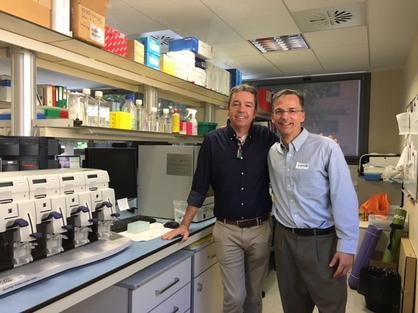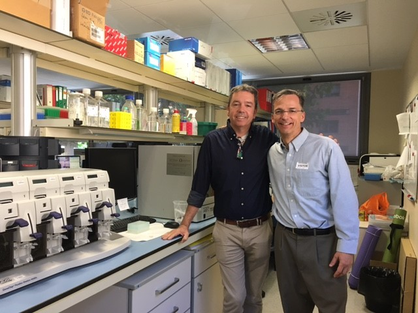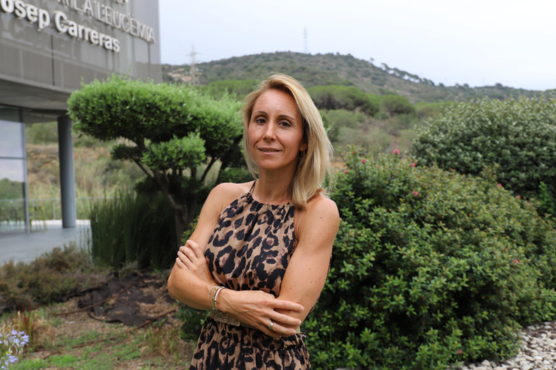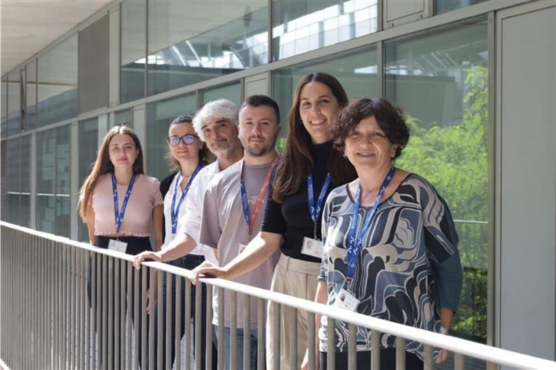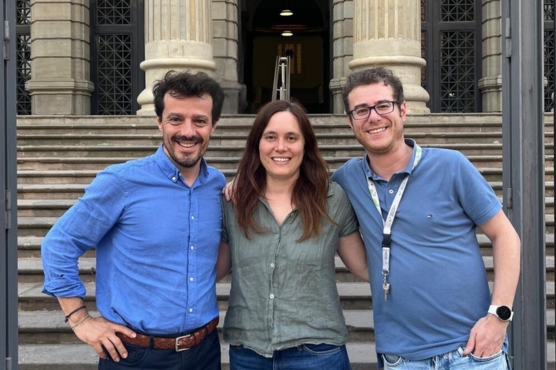“The better a process is understood, the better it can be controlled. Accessibility of blood has given us a rich understanding of leukemias”.
We had the great pleasure of hosting Dr. Tomas Radivoyevitch at the Josep Carreras Leukaemia Research Institute’s Germans Trias i Pujol Campus on May 16th. Dr. Radivoyevitch holds an Associate Staff position in Cleveland Clinic’s Department of Quantitative Health Sciences. The seminar he gave covered both his work on leukemia risk dynamics after diagnoses of 1st cancers and other work in which he hypothesized that myelodysplastic syndromes (MDS) with SF3B1 K700E mutations expand hematopoietic stem cell (HSC) numbers by decreasing the activity of the iron-dependent protein Tet2. The two most mutated genes in MDS are TET2 and SF3B1.
Dr Radivoyevitch’s original training (Case Western Reserve University) and work experience (Bailey Controls Company) were in control system engineering. His long-term goal is to leverage this against cancer by producing mathematical models that will help researchers optimize patient state feedback rules that determine/support treatment decisions. As blood samples are more accessible than tumor samples, he expects applications of feedback-based control to be realized for leukemias before solid tumors. This is why his research focus has been on leukemias.
Dr. Radivoyevitch enjoys cycling to work. He also enjoys fixing things. His role models are the Amish from whom he learned to keep life simple, LeBron James who inspires him to form a team of champions, and his father, who was diagnosed with acute myelomonocytic leukemia in 1985 and was cured, overcoming ~1/10 odds similar to those faced by Josep Carreras. Coincidentally, some of Dr. Radivoyevitch’s fondest memories are of his father singing opera for fun, either with his mother on piano or while kayaking on a quiet lake in a forest. Dr. Radivoyevitch has a wife and 4 children (ages 16 to 21). He enjoys family dinners, particularly those on their front porch.
We asked Dr Radivoyevitch about the challenges ahead for research in his field.
● Dr Radivoyevitch, you have talked about the application of mathematical models in order to achieve better therapies. Could you explain for a non-scientific audience, how math can help the research?
It’s really about dealing with information overload. Automatic control systems, such as the ones that fly airplanes automatically, use mathematical models both to design controllers and to test them out in computer simulations. Automatic control systems can assimilate lots of information faster than humans. The use of autopilots in airplanes, wherein many human lives are on the line, predicts that eventually, oncologists will also be replaced by autopilots, i.e. control systems that determine drug choices and doses in real-time based on current patient state information.
● What are the advantages of the mathematical models in the study of haematological malignancies?
The better a process is understood, the better it can be controlled. Accessibility of blood has given us a rich understanding of leukemias. For example, the Philadelphia chromosome was one of the first DNA alterations known to cause a cancer and today chronic myeloid leukemia (CML) is a well-controlled disease. Blood accessibility also enables denser feedback signal sampling times. This too should improve our ability to control haematological malignancies. Bear in mind that the track record of successfully using mathematical models to improve control is in engineered systems, wherein understanding was rich enough to build the machine. This predicts that mathematical modelling will impact oncology first through well-understood cancers.
● You are interested specifically in the study of myeloid cancers. What progress has been made over recent years with the use of this technology?
Control theory was applied to mathematical models of chronic myeloid leukemia (CML), but this work did not receive much attention, perhaps because CML is perceived to be a solved problem without mathematical modelling. CMML (chronic myelomonocytic leukemia) remains unsolved. It is more complex than CML and is thus less likely to be well-controlled without mathematical modelling. This is why I shifted my focus over the past 2 years from CML to CMML.
● Regarding your speech Estimating leukemia risk dynamics after diagnosis of first cancer treated or not with radiation, what are the main conclusions of this analysis?
MDS risks are ~2-fold lower than AML risks after non-hematologic 1st cancers, roughly equal after lymphoid 1st cancers, and ~3-fold higher after lymphoid 1st cancers treated with autotransplants. If lymphoid-MDS correlations were due to mutation accrual in HSC, one would expect the same mutations in both cancers. This is not observed. My best guess then of what might be going on is the following. Mutations cause HSC expansions into more oxic DNA-damaging marrow niches. This creates antigenic passenger hits that cause an immune response. Chronic stimulation of lymphoid cells predisposes them to also gain mutations and this gives rise to a lymphoid cancer with independent memory cell mutations. That TET2-/- mice expand HSC, and TET2 mutations are more common in MDS than in AML, suggests that autotransplants expand HSC with decreased TET2 activity. This predicts that 5-hydroxy-methylcytosine enzymatic products of Tet2 should be lower in MDS arising after autotransplants for lymphoid cancers than in MDS in general.
The second half of my talk focused on CMML. TET2 is mutated in ~50% of CMML cases, i.e. higher than in any other cancer. I believe TET2 suppresses CMML by decreasing both the number of HSCs and their exposure to oxygen, i.e. by decreasing the number of target cells and the rate at which they mutate; the protein Tet2 may limit HSC numbers by turning on differentiation genes as HSC spend more time in oxic niches. Myeloid cancers that lost Tet2 activity may thus have HSC that remain HSC even when they are in oxic niches. Because Tet2 depends on iron in cell nuclei, and because MDS cases with SF3B1 K700E mutations accumulate iron in mitochondria, I hypothesized that SF3B1 K700E mutants expand HSC via Tet2 activity losses. I presented several lines of evidence supporting this view and am now ~95% sure that it is correct. Certainty could however be improved by directly measuring iron in SF3B1 K700E cell nuclei. I am hopeful that IJC’s iron expert Dr. Mayka Sanchez will be able to help with this.
● The Josep Carreras Foundation has established a research centre specifically for leukaemia and other malignant blood diseases, the IJC. Which repercussions do you think this could bring, both for medical science and for society at large?
Blood cell mutations in TET2 and SF3B1 are found in many “healthy” elderly individuals. Mathematical models Tet2 activity in HSC of such individuals could be used to look for ways to help good HSC more than bad HSC. For example, if only one copy of TET2 is lost, vitamin C might increase TET2 activity of bad HSC and thus help, but one must then also worry about it also decreasing good HSC numbers. Mathematical models of competing good and bad HSC could help us quantify the extent to which an intervention helps more than it hurts. Mathematical modelling may not be as critical where choices are clearer, e.g. if both copies of TET2 were lost, lowering iron would not be expected to help bad HSC, but may still help good HSC.
Although my long-term goal is to apply control theory to myeloid cancers low in Tet2 activity, I realize that controllers are never better than the process models upon which they are based. My current emphasis is thus on understanding Tet2. As such understanding accrues, and credence in Tet2 mathematical modelling grows, I will then explore uses of such models in control system design. I hope to reach this top level of my research mission in 5 to 10 years.



